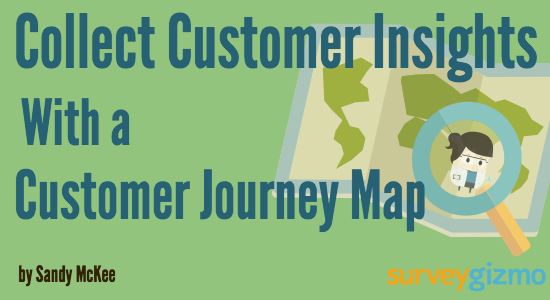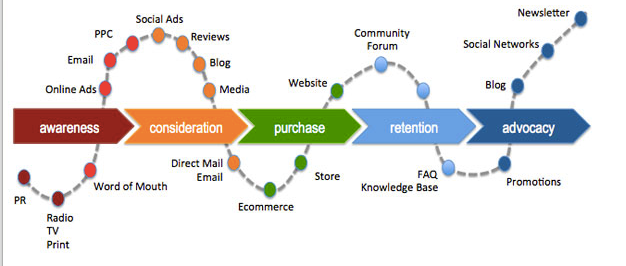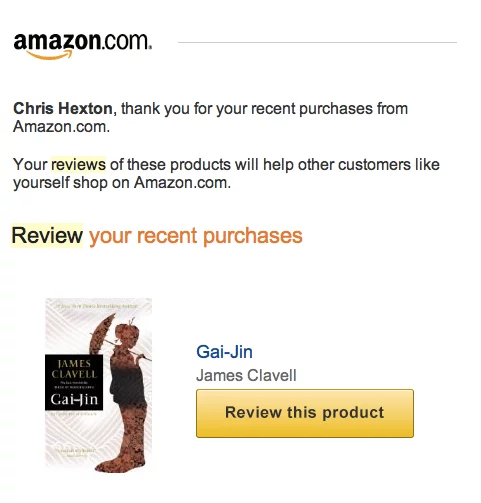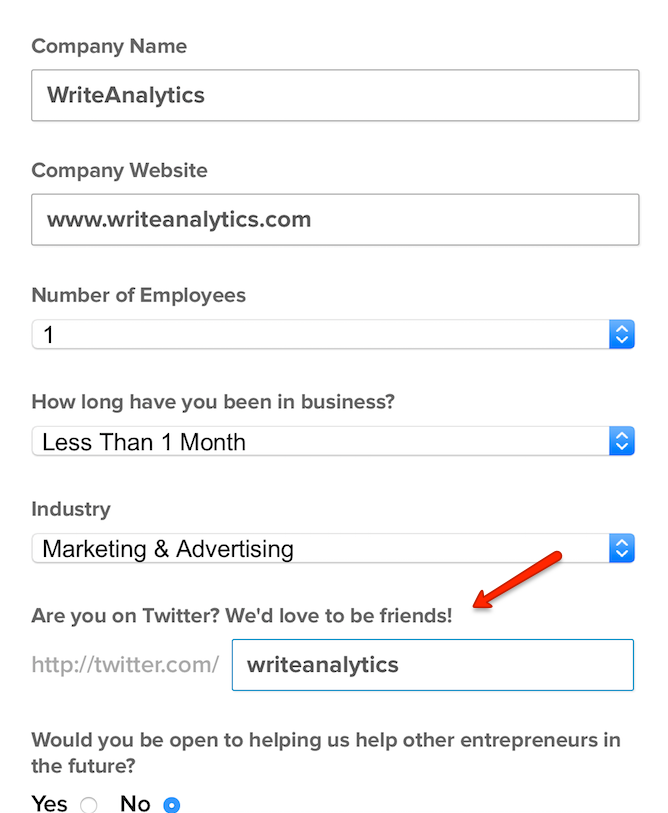Today’s savvy consumers not only prefer, but also expect personalized and targeted brand messages. According to Accenture Personalization Survey: “More than half (60 percent) say they want retailers to be able to issue personalized, real-time promotions, and in exchange for personal information, consumers expect rewards and benefits such as exclusive deals (64 percent), one-time discounts (61 percent), and special offers (61 percent).” The opportunities exist for brands to invest in using consumer data to deliver a highly valued service to their customers, but there’s a catch. Implementing a customer journey map can help brands navigate this landscape by understanding the nuanced pathways consumers take towards making purchasing decisions.
Only 20 percent of buyers want retailers to know their current location, and only 14 percent of online shoppers want to share their browsing history.
Clearly, consumers are conflicted. They want targeted deals, but they’re reluctant to give away all their personal details. By creating an accurate map of your customer’s journey and delving deeply into their experiences with your brand, you can help ease this reluctance and deliver an outstanding experience at every encounter.
How To Collect Consumer Insights
Brand awareness and customer satisfaction surveys are great ways to gain consumer insights.
The data you collect allows you to build consumer personas that your marketing team can identify with. By knowing who your core market is, you can make some general assumptions about product, marketing, and more.
These surveys are a good place to start in understanding your customers’ needs, but this data can be flawed since consumers’ recall is not always accurate.
To make more accurate predictions about customer needs and preferences, you need to collect consumer data at various points throughout the sales cycle.
Consider these best practice tips when collecting consumer insights.
3 Steps For Collecting Consumer Insights
- Build Trust
The most important step to collecting consumer insights is to build trust.Consumers are only comfortable providing information about themselves once you have earned their trust. Just like dating (or any relationship for that matter), if you ask for too much too early, you will scare them away.
Your goal is to assist your customers in their purchase decision and build a long-term relationship. Keep your users’ experience positive. Build credibility by continuously offering valuable information that addresses their issue. People will only give information if they feel they have something to gain from it.
- Map your customers’ journey
Mapping your customer’s journey through your sales funnel will help you better understand your customers’ experience and identify gaps that prohibit them from easily getting to the next step.Journey maps are typically displayed as an infographic or storyboard with a timeline of the user’s experience. They should highlight your users’ needs, questions, and feelings through each phase of the funnel.
Image source: customerthink.comKeep it simple. You don’t need to map every aspect of your customer’s experience. The goal is to focus on key touch points and understand what motivates users to take the next step in the purchase process.
Use it to gain a clear picture of where your users come from and what they need so that you can improve their experience by delivering more targeted and personal messages.
- Identify customer touch points
Next, identify customer touchpoints at each phase of the sales funnel. Collaborate with other departments who have front-line interactions with your customer, such as sales and support, to get their input and fully understand your customer’s experience.These points are your opportunity to learn a little bit more about your customers. Use them to determine who your customers are and what painpoint they are trying to resolve.
Again, avoid asking for too much information all at once. Spread your questions out over time so as not to seem intrusive. Keep in mind, you are still in the process of earning their trust.
Mining the Sales Funnel for Consumer Insight
Now that we’ve got our map in place, we need to examine the various stages of the sales funnel to find opportunities to get insight in the customer’s mindset and motivation.
Consider these key sales funnel phases as opportunities to glean customer insight.
Consumer Insights Phase 1: Visits
Start with how visitors found you.
Website analytics:
Website analytics provide a lot of information on where users have come from and what they are interested in. Be careful though not to make false assumptions. For instance, the fact that a user visited a page may not mean that they are interested in that feature or service.
It could be that they aren’t finding the information they are looking for elsewhere on the site. Look for engagement indicators such as time on page and next page to get the full story.
Website intercept:
Consider using a website intercept survey to determine if visitors found the web content they were looking for and to find out how easy was to navigate through your website. This is a good time to ask about the problem they are hoping to resolve.
Different marketing channels provide different aspects for learning something about your audience. For instance, if your customers are on social media, engage them there to learn more about their experience before, during, and after they engage with your brand.
Social media channels:
Marketers have been using social media to collect feedback and monitor brand sentiment for a while, but we are just beginning to tap into the data available in a customer’s social profile.
“Data in our social profiles is incredibly valuable to a marketer because it’s declared, first-person data and thus, highly accurate. Instead of having to infer characteristics about a person based on their behavior (pages viewed, products browsed/purchased, etc.) brands can gain access to demographics and psychographics that can help form a more rounded view of the individual.” – Bill Piwonka, Vice President Marketing at Janrain.
Consumer Insights Phase 2: Leads
Email marketing is still one of the most powerful marketing mediums for nurturing leads.
Use your email series to learn more about these leads so that you can better segment them and deliver relevant content.
Each email should provide value with a clear call to action (CTA). One CTA may to be write a review for your product. Since most reputable review sites require user authentication (usually in the form of linking to a social media channel), you can learn not only about their experience but who they are.
Here is an example from Amazon:
Consumer Insights Phase 3: Qualified Leads
What consumer signals indicate that a lead is interested? Signups are a sure indicator.
Grasshopper, a division of Citrix that lets entrepreneurs run their business using their cell phone, has a great signup form.
They keep their form short but still manage to ask a few basic questions about who is signing up without being too intrusive.
Here’s their signup form:
Did you notice this awesome question:
“Are you on Twitter? We’d love to be friends!”
What a great idea! As mentioned earlier, you can learn a lot about your customers who are on social media by looking at their social profile. With better insight, it is easier to engage them in a casual conversation without seeming pushy. Now you can continue build an organic relationship.
Consumer Insights Phase 4: Sales opportunity
Use transactional events as an opportunity to gain collect customer data.
Look at recent customer history to determine traits and actions that signify a purchase is imminent. This might be the number of page views or events such as downloading a report or registering for a webinar.
HubSpot suggests this:
“List all the activities that a lead can take before becoming a customer, and analyze the close rate for each one. For example, to determine the close rate for a webinar, look at all customers that had watched a webinar, then divide that number by the total number of leads that originally registered for the webinar. “
Events are the perfect time to collect more insight. For instance, when a user signups for your webinars or seminars, ask for the organization they work with and what their role is. But there are other opportunities too.
Webinars:
For instance, you know that brief window before a webinar starts where you are waiting for everyone to log in? This is an opportune moment to engage attendees with a poll asking them what they hope to achieve by using your product or service.
Collecting this information not only engages attendees, but the resulting metrics give you additional speaking points during the webinar.
After your webinar, don’t forget to seek feedback. An evaluation survey allows you to make course improvements but you can also collect additional customer insight at this point so that you can better address their needs in the future.
Online documentation:
An area that is often overlooked for collecting feedback or insight is online documentation. If your organization provides online help, ask visitors if they found the content they were searching for and if not, what were they looking for. This will allow you to fill content gaps and prove better better service. By implementing this at Alchemer, we saw a decrease in support calls and a subsequent reduction in our overall support costs.
Consumer Insights Phase 5: Loyal customers
The Net Promoter Score (NPS) is the best way to determine your loyal followers. If your customers are willing to recommend your brand to colleagues and friends, then you knowing you are exceeding their expectations.
Be sure to ask them why they rated your product or service favorably and then ask if they would like to provide a testimonial or review. This consumer insight will let you know where you excel so that you can use it as a strong value statement in your web content and promotional material.
Consumer Insights Give You a Competitive Edge
Understanding your customers well is crucial for delivering the right information at the right time, through the right channel. Build trust and confidence by delivering targeted content that aids them in their purchase decision.
Map your customers’ journey so you can continuously improve customer engagement and acquisition. Customer journey maps are a powerful tool that paint a clear picture of customer questions and feelings so that you can best address their needs.








